
The most unusual of Spain’s major highways is the A-7. Successor to the N-340, this huge road runs from Algeciras to Altafulla. Its large extension means that it has several important gaps, especially in its northern segment. In addition, the AP-7, a motorway that complements the Mediterranean motorway and is in the process of being liberalised, runs parallel to it. This route along this great corridor allows you to see castles, mountains, beaches and enjoy one of the best cuisines in Europe.
The ends of the A-7 are undoubtedly its most complicated segments. Both at the beginning and the end of the road it is incomplete and you have to use the AP-7 if you want to drive normally. When you leave Algeciras there is a section that does serve as a motorway. However, it ends at Guadiario, in the municipality of San Roque, near the change of province from Cádiz to Málaga.
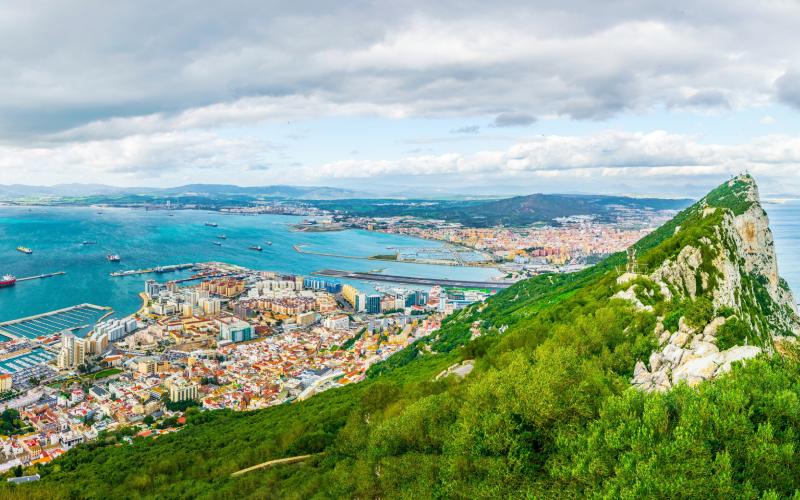
View of the Bay of Algeciras. | Shutterstock
From here and to Marbella, although it is called Autovía del Mediterráneo, in reality it is the old N-340. The good thing is that it follows the line of the coast and there are great landscapes to enjoy. Also, the climate is usually mild despite the winds and there are no particularly dangerous stretches. Estepona, famous for its cuisine, and the nearby Sierra Bermeja are the most interesting landmarks through which this peculiar part of the A-7 passes.
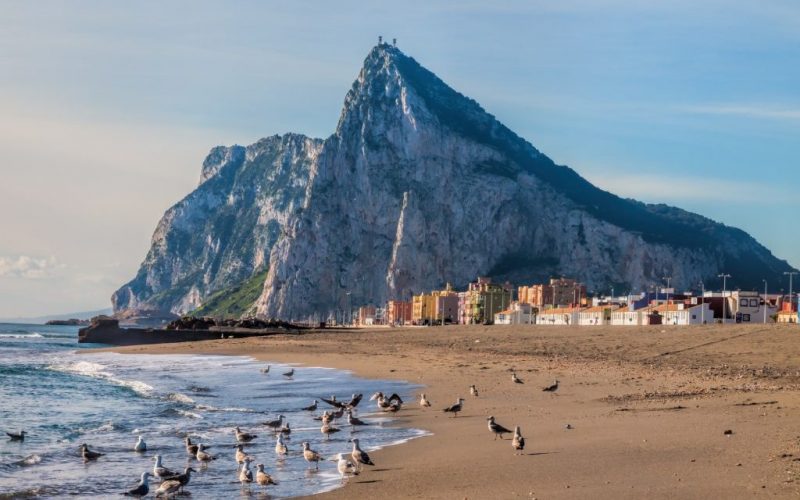
Beaches of the Línea de la Concepción with the Peñón in the background. | Shutterstock
In any case, the Andalusian exit of the A-7 has a clear protagonist, the Strait of Gibraltar and its natural environment, which reaches Tarifa. The bay of Algeciras is part of it. Although it has a notable industry, its function for water and migratory birds is vital. The union between the Mediterranean and the Atlantic was also a key strategic point for the European powers. An unrivalled example is the British colony of Gibraltar. Its capture by the British meant the creation of San Roque, La Línea de la Concepción and the repopulation of Algeciras.
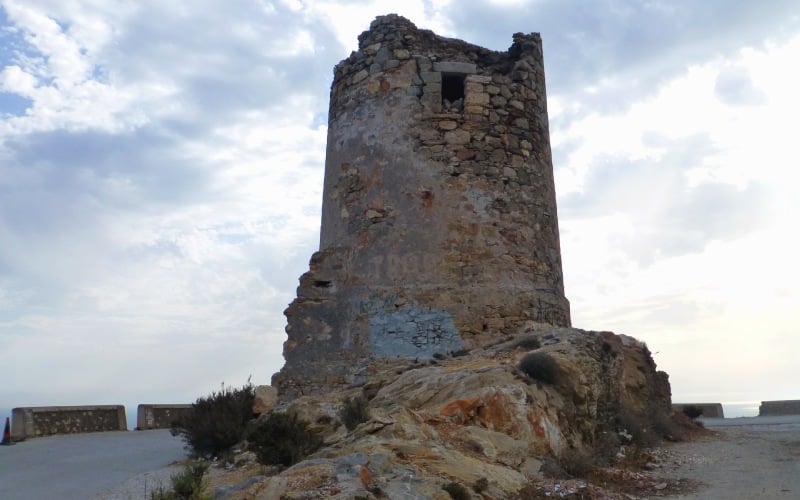
Zambullón Tower, with the actual circular shape. | Shutterstock
For centuries the Berber pirates were the biggest threat to the Spanish Mediterranean coast. Their razias were devastating to the near-shore gardens and fishing populations. Considering the importance of tuna and tuna traps in Andalusia and the Levante, this was a total disaster for the nobility, the crown and the people. Thus, Philip II decided to create a plan to stop the assaults. The towers were circular, while the condales, like those of the Lord of Medina Sidonia, were square.
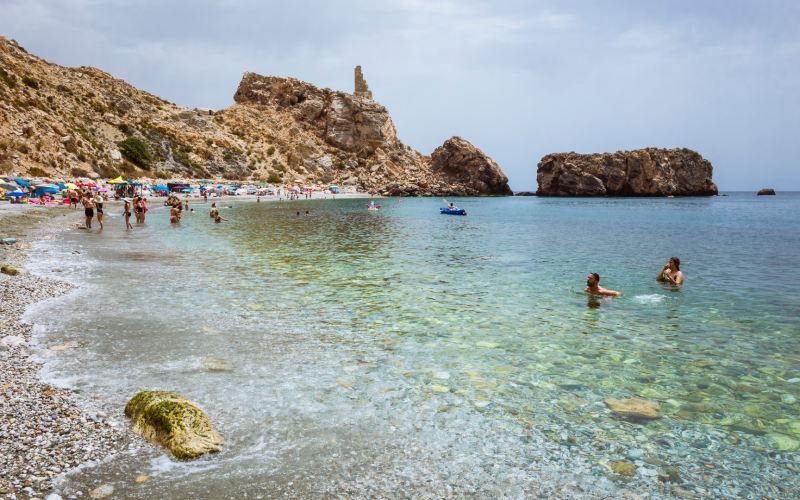
La Rijana beach and tower, Castell de Ferro. | Shutterstock
All along the affected coast, it set up watchtowers to warn the local contingents. In this way it was a matter of saving the settlers and inhabitants. The area around Cartagena was the first to be reinforced. Later, defences would arrive in other places. In places like Conil, Zahara, Barbate, Vejer, Torre del Mar or Castell de Ferro several of them still survive. Huelva, Cádiz, Granada, Málaga and Alicante were the main centres to defend. Almería, the Balearic Islands, Gran Canaria and Tenerife also ended up receiving towers.
Between Marbella and Almería, the A-7 runs along the coast. Thanks to this, the possibilities for making a stopover are great. In the area of the strait there are already those of La Línea de la Concepción and San Roque. Once in Málaga, the above mentioned seafaring town of Estepona or Manilva has pleasant sandy beaches. Other beaches which can be reached by following the road are those of Marbella, Fuengirola, Mijas, Benalmádena, the capital of the Costa del Sol, Torremolinos, Torre del Mar, Torrox and Nerja. In the background there are mountains like those of the Montes de Málaga or the Almijara.
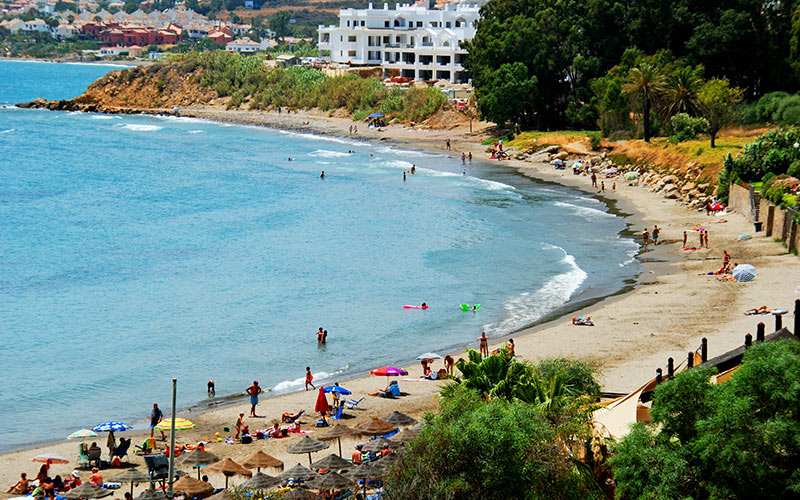
Beach in Estepona. | Shutterstock
The same goes for Granada with its Costa Tropical. In its case, it is the foothills of the Sierra Nevada that provide the slopes. As for the most notable locations to test the water of the Mediterranean, there are many to choose from. In the westernmost part, Almuñécar and Salobreña stand out. Towards the centre, Motril and Castell de Ferro are great alternatives. Finally, towards Almería, La Rábita or the municipality of Polopos also have several beaches to offer.
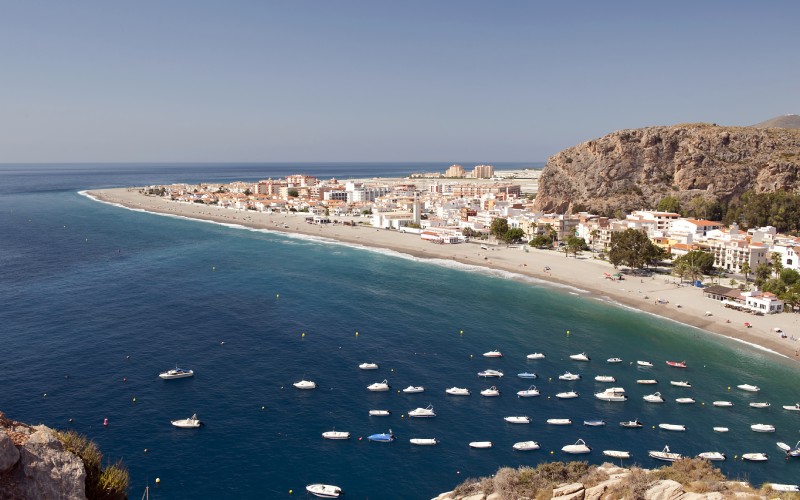
Calahonda, near Motril. | Shutterstock
The province of Almería is the last province through which the A-7 passes before it flows into Murcia. Its horticultural environment is complemented by tourist towns such as Roquetas de Mar or Mojácar. El Ejido or the capital of Almería also has some very attractive beaches. When turning inland at Cabo de Gata, the Alhamilla mountain range and the Almanzora Caves are worth mentioning.
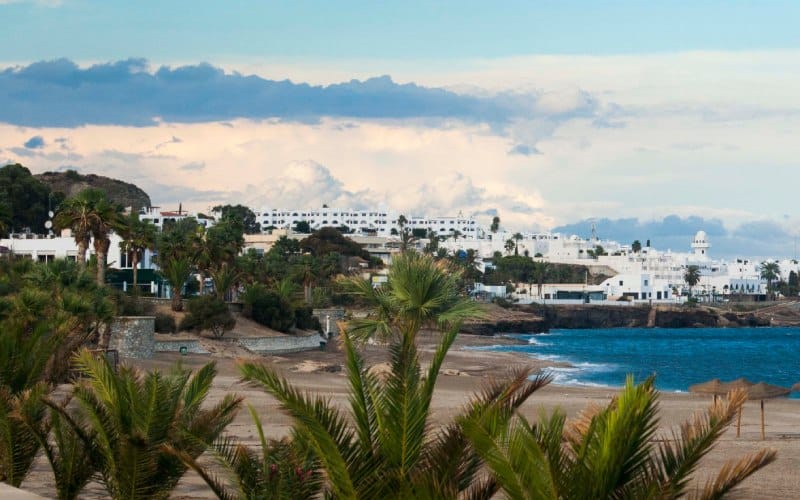
Mojácar. | Shutterstock
Although the Autovía del Mediterráneo has a strong aroma of the sea, it is home to the most important horticultural cultivation areas in Spain. The first of them is in Almería, in the surroundings of El Ejido and Roquetas de Mar. This is the Mar de Plástico. A gigantic agglomeration of greenhouses extends over Campo de Dalías. Thanks to them, the province is one of the main exporters of vegetables in Europe. Its tomatoes are especially famous.
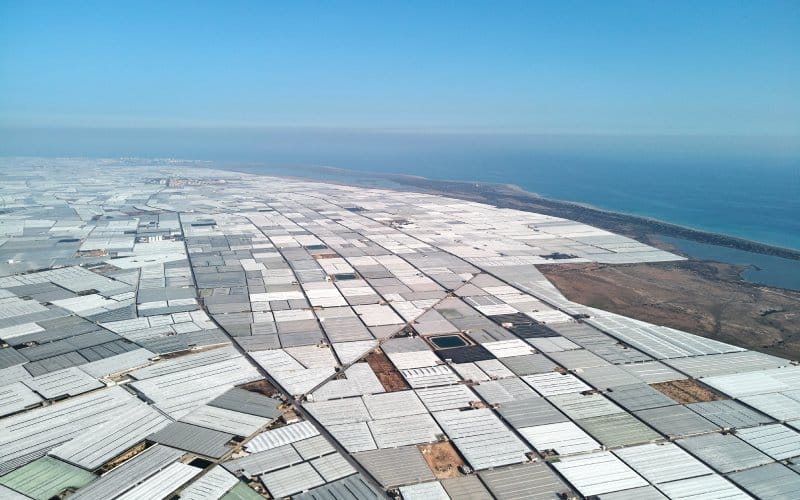
Mar de plástico in Almeria. | Shutterstock
Further on, the Huerta de Murcia awaits, a historic region led by the provincial capital. Despite the aridity of other areas in the region, this orchard, supported by the Segura basin and indirectly by the Tagus basin, produces the best lemons in the country. Its tomatoes, beans and courgettes also have a great reputation.
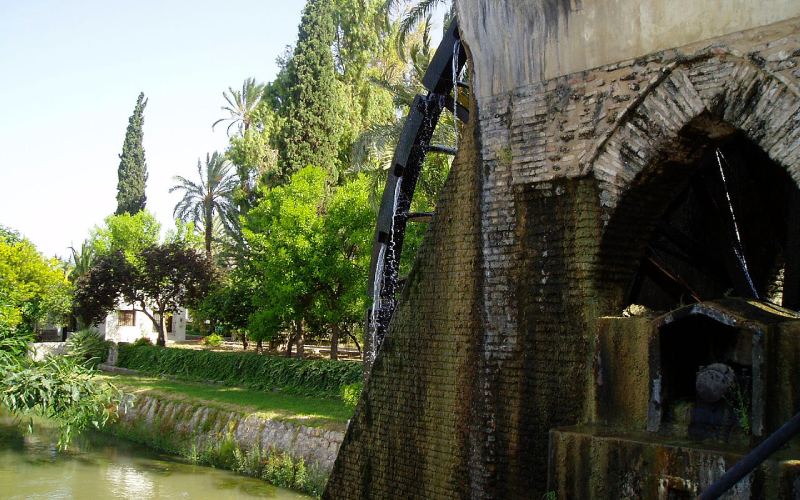
Rueda de Alcantarilla. | Wikimedia
The A-7 runs along much of it. Before entering the Huerta de Murcia it passes through Lorca. This town has a great heritage, such as its medieval castle or the collegiate church of San Patricio. It is worth noting that it is the second largest municipality in Spain, after Cáceres, and it reaches the sea. Almost in the capital is Alcantarilla, a neuralgic centre in the garden. Its wheel is a symbol. It is a waterwheel that helped to carry the water to the highest ditches of the place. It is worth noting that the vegetable gardens of Alicante and Valencia were also extraordinary producers in the past, although today they are languishing in comparison with those of Murcia and Almería.
While the sea offers an open door to trade, it also offers an open door to assaults. This has already been seen in the case of the Berber pirates, whose actions required the construction of a whole network of watchtowers and forts. But the Spanish Mediterranean coast was already fortified. For this reason, castles are a constant throughout the A-7.
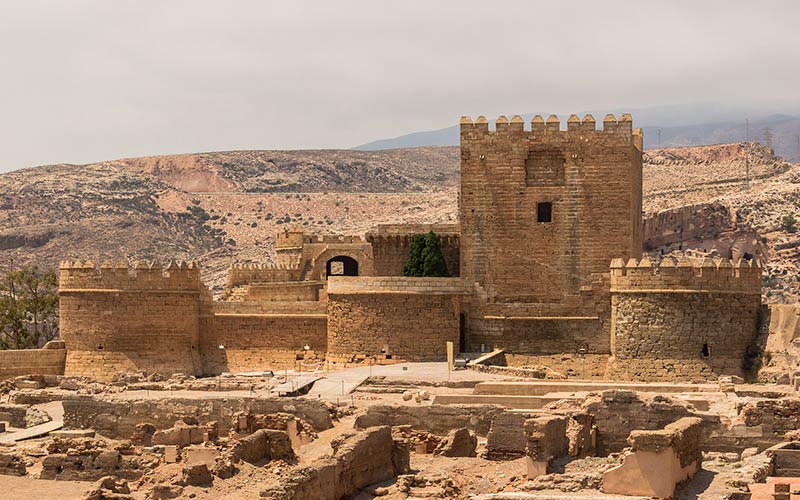
Christian enclosure of the Alcazaba of Almería.
The Alcazaba of Almería, for example, was the second largest in the Caliphate of Córdoba. The Christians worked on the first Arabic factory to adapt its imposing defences over the years. Active until the first Carlist war, today it is a consolidated building. The origin of Málaga’s Sohail Castle, in Fuengirola, is also caliphal. Very well preserved despite the damage caused by the French in 1812, it directly dominates the A-7 pass.
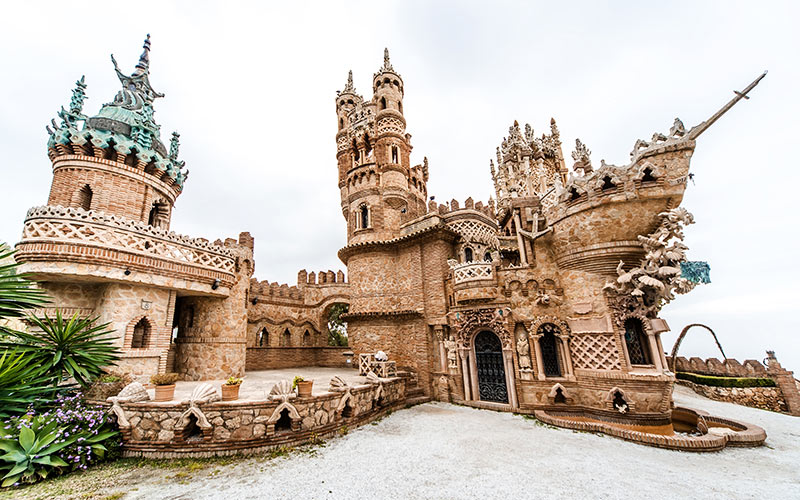
Colomares Castle in Benalmádena.
Also Andalusian and Arabic is the castle of Castell de Ferro, in Granada. There are hardly any remains of its initial work, but the complex it forms together with the nearby watchtowers makes it worth stopping to see. It is also worth mentioning the castle of Colomares, despite the fact that it dates from the end of the last century and was never used for defensive purposes. Made in Benalmádena, it pays homage to the Catholic Monarchs and Christopher Columbus with a colourful mixture of styles.
The A-7 motorway passes through Murcia, leaving several castles of great interest nearby, such as Lorca. Despite being impregnable for centuries, the earthquake that the place suffered in 2011 caused a lot of damage to a tower and the walls. Meanwhile, the castles of Monteagudo, on a spectacular rock, and Larache are also worth seeing. Both were part of the same Arab complex.
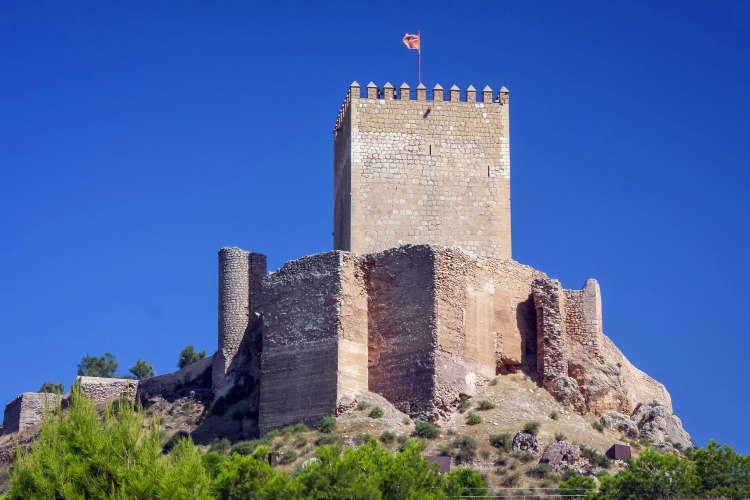
Castle of Lorca. | Shutterstock
Alicante has one of the best medieval castles in the whole of the Autovía del Mediterráneo. Named after Santa Bárbara, it is a recurring film set due to its great state of preservation. The visit is easy thanks to a lift that goes up to the top of the fortress. From there there are great views of the coast and the city. The strong enclaves of Villena, Sagunto or Oropesa are also impressive.
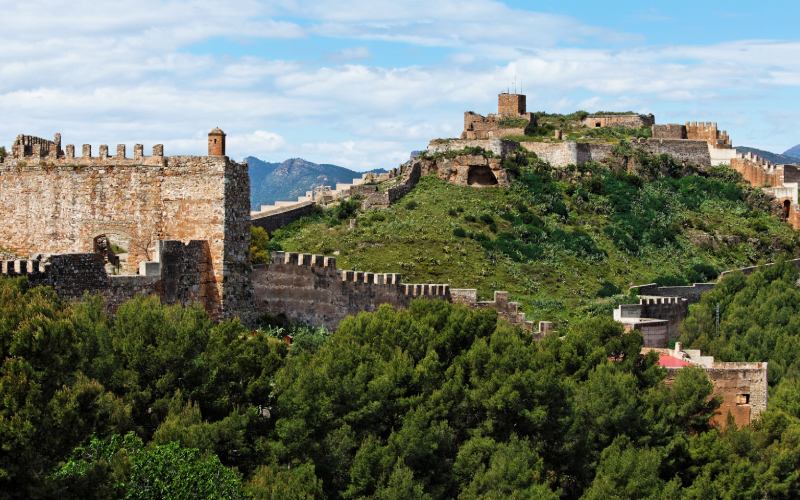
Castle of Sagunto.
Papa Luna’s palace is a landmark Templar castle in Peñíscola. The knights took advantage of a citadel and when the order was dissolved it passed through different hands. The religious one that gives it name is without a doubt the most famous of all them. In Castellón de la Plana, the castle of Fadrell gave its name to the city, but hardly any notable remains remain. Its cistern contains the hermitage of La Magdalena.
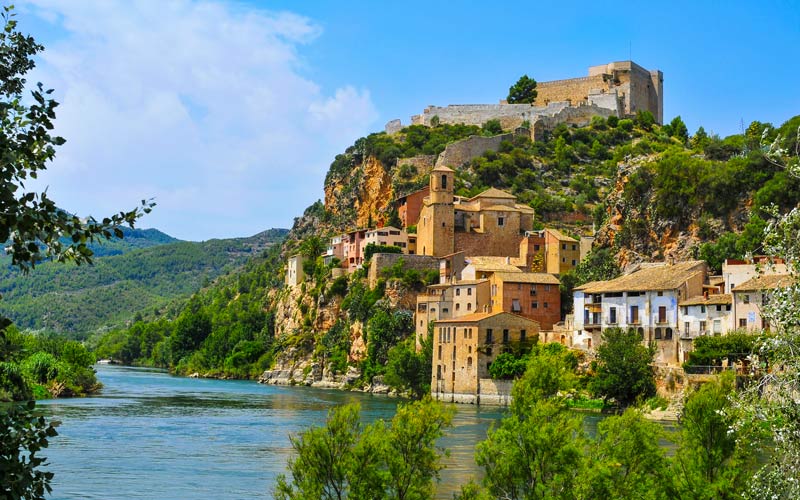
Templar Castle of Miravet.
Finally, in Catalan territory there are several extraordinary fortresses on the side of the A-7, such as those of Altafulla. The castle of La Zuda in Tortosa has, like that of Pope Luna and the following one, a Templar past. The participation of the knights in the capture of the city was the key to its being handed over to them. Although it is impressive, Miravet Castle is even more impressive. On the Ebro, the people settled around it and saw one of the last signs of resistance from the order of the kingdom of Aragon. Both are key to any Templar route visiting the north of Spain.
After the Region of Murcia it is the turn of the Valencian Community. An essentially inland road awaits the capital, Valencia, which runs between imposing mountain ranges. The village of Miguel Hernández has a beautiful cathedral, churches and monasteries. The ruins of the castle of Orihuela are also worth mentioning. Not far away, Elche conserves an extensive heritage dating back to pre-Roman times. Its palm grove is the largest in Europe and a World Heritage Site, as is its most famous tradition, the Mystery of Elche.
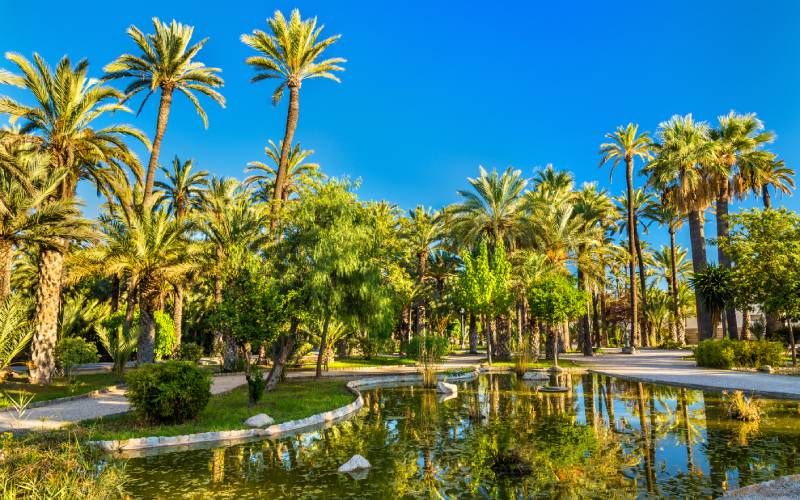
Palm Grove of Elche. | Shutterstock
Alicante is the next town to know about the A-7 in the direction of Barcelona. There is a free ring road, the A-70, to avoid the AP-7. Once past the capital, whose attractions are dealt with below, the Sit mountain range stands out. A short detour allows you to see the Jijona nougat factory, while Elda and Villena are also just a stone’s throw away.
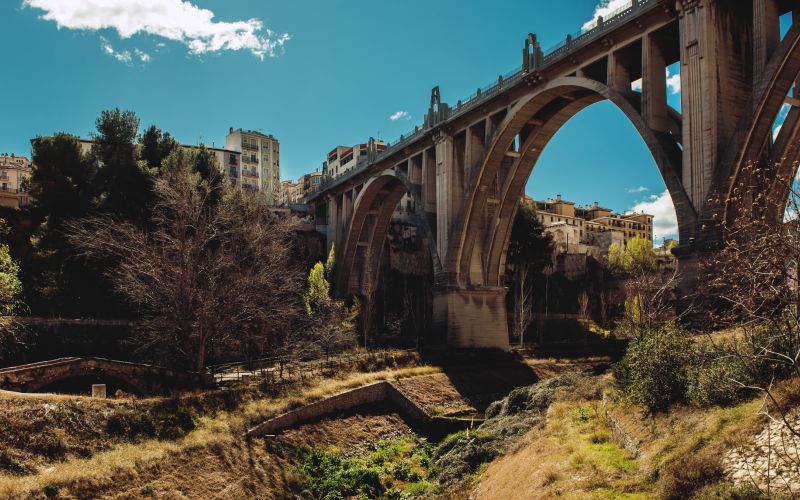
Sant Jordi Bridge in Alcoy. | Shutterstock
Only 20 kilometres separate this area from the Sierra Mariola Natural Park, with Alcoy at the foot of the motorway. This city has the mountain embedded in its veins, through ravines that mark its layout. Squares, fortresses and temples are another of its attractions. From here the road faces Valencia and approaches the coast again. Two stops to take into account are Xàtiva and Alzira.
Valencia, which can be reached by the A-3 from Madrid, is bypassed by a free section of the AP-7. In fact, the road is toll-free from Alicante to Tarragona. Thanks to this, the lack of any of the final sections of the Autovía del Mediterráneo can be solved. In Sagunto, famous for its Roman remains, in the shadow of the Sierra Calderona, you briefly return to the A-7 before it becomes the CV-10 at Vilavella. Continue to Villanueva de Alcolea, where it will disappear for several tens of kilometres.
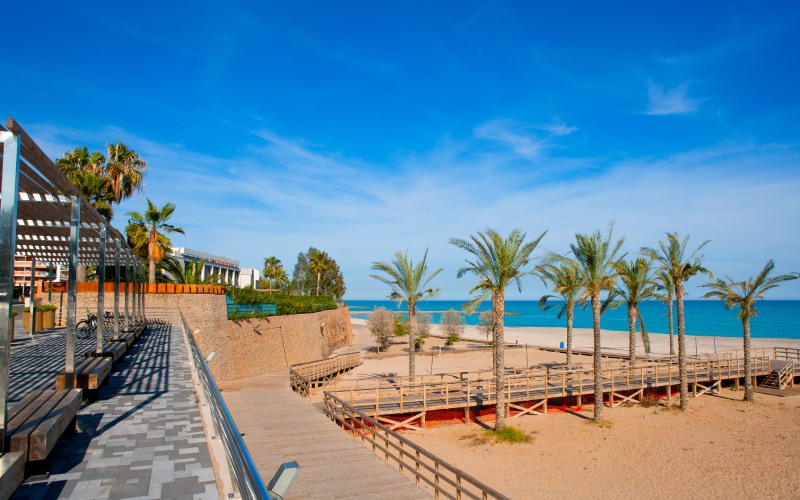
Benicassim and its beaches. | Shutterstock
For all these reasons, the recommendation is to opt for the Autovía del Mediterráneo from Sagunto. It should not be abandoned until Catalonia, in Hospitalet del Infante. This alternative also allows you to stay close to the sea. Nules, Burriana or Villarreal are towns next to which the AP-7 passes. The beaches of Castellón are still excellent. Benicassim’s beautiful 19th century villas are particularly outstanding, when it was consolidated as a major tourist town. Oropesa, on the other hand, is a reference in sun and beach tourism. Almost on the border, past the Sierra de Irta, Peñíscola and its imposing castle are between the road and the sea.
The Ebro Delta not only offers a great natural spectacle, but also opens the doors to two towns that are very important. One is Amposta, next to the river and the AP-7. The other is Tortosa, a town with an epic past very much tied to the orders of knights. On the way to Hospitalet del Infante is L’Ametlla de Mar with its beautiful beaches.
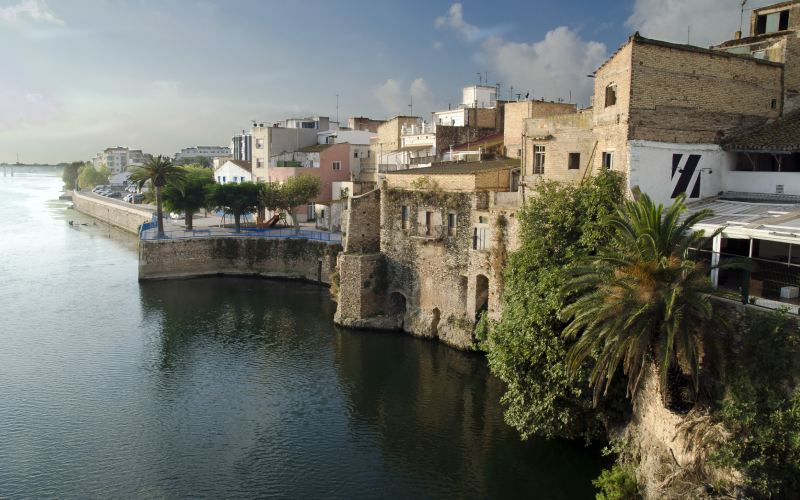
Amposta and the Ebro. | Shutterstock
The only thing left to do is to face the actual end of the route to Tarragona. The route hardly changes. Cambrils or Salou are possible detours to the beach, while Reus has several modernist displays, such as parts of its magnificent cemetery. La Móra, about 10 minutes from the capital of Tarragona, puts an end to the A-7 in practice.
To get to Barcelona from La Móra there are several alternatives. On the one hand, you can follow the old N-340, whose project to split into two in the area has never been completed. It points to Vilafranca del Penedès, passing by the Foix reservoir or the Bonastre Massif. From there it goes into the Ordal mountains until it joins the A-2 just before it becomes the Ronda Litoral.
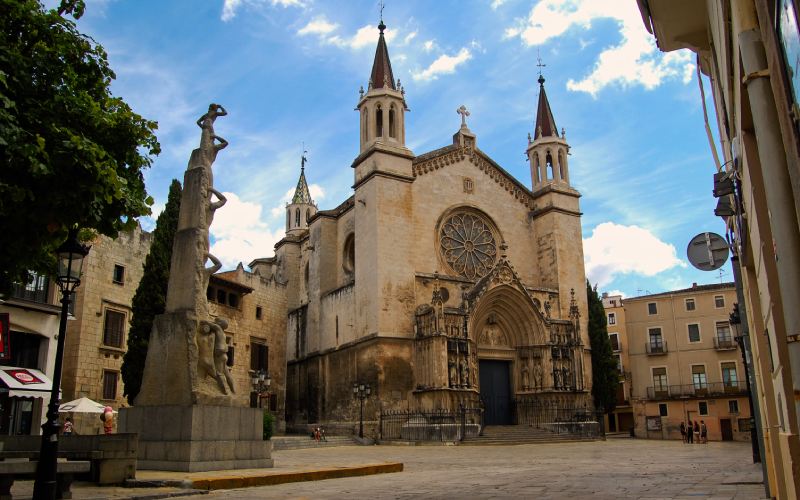
Church of Santa Maria in Vilafranca del Penedès. | Shutterstock
On the other hand, there is the option of the AP-7, whose tolls have their days counted. Up to Vilafranca the transfer is similar to that of the N-340, but faster of course. However, there it follows a more northerly direction. As you head towards Martorell you leave the beautiful Sant Sadurní d’Anoia at your feet, with its enormous legacy around the cava. Once near Barcelona, the entrance is next to the Serra Collserola Natural Park.
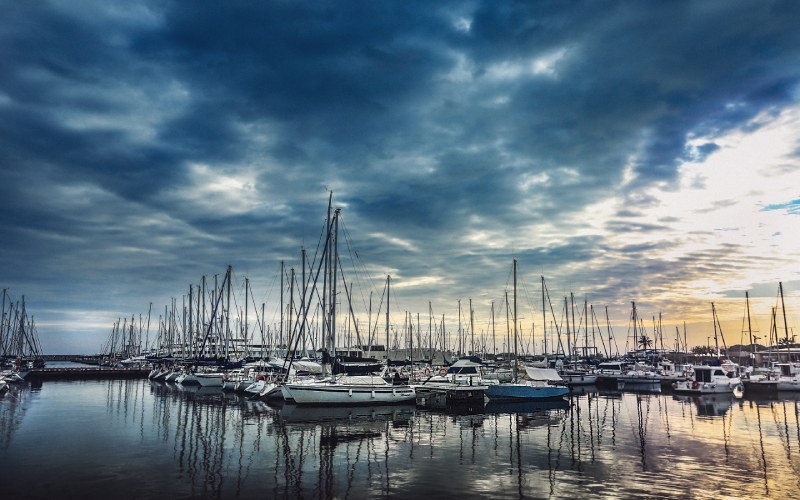
Port of Vilanova i la Geltrú. | Shutterstock
Finally, there is a third way, which runs by the sea. Until Calafell you have to go by the N-340, but there you will derive to the C-32. Next to this road you will find charming towns such as Vilanova i la Geltrú and Sitges. Between the Mediterranean and the Garraf mountain range you continue to move forward to reach Castelldefels. This means that we are now in the metropolitan area of Barcelona.
Along the A-7 you can get to know some of the most important cities in Spain. Many of them were imposing medieval ports and others have been built as agricultural emporiums. Their culture and monuments make them prime stops for any route along the Autovía del Mediterráneo, the sea that supports and sustains them.
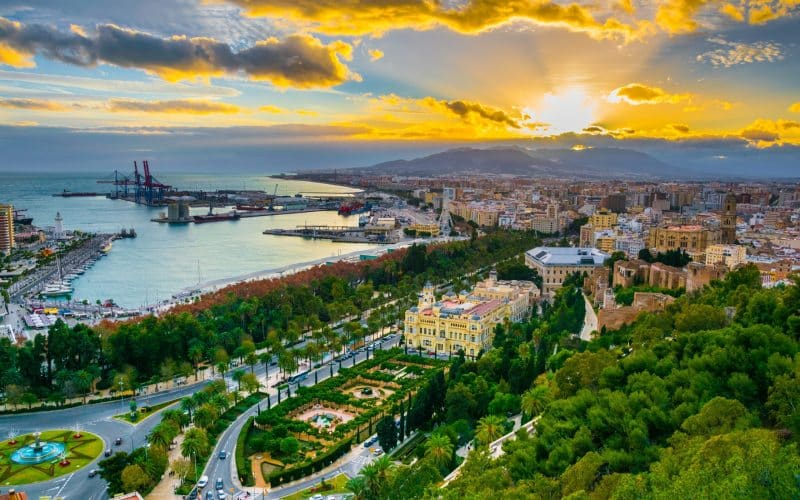
General view of Malaga. | Shutterstock
The first of all these notable locations is Málaga. The capital of the Costa del Sol offers great culinary opportunities, also at a very good price, as well as an enormous amount of art to be shown. Not in vain, it is the birthplace of Picasso. A great port, it had a wide English activity in the 19th century and beginning of the last. Its cathedral, bullring or beaches are other unquestionable attractions.

Almeria’s train station. | Shutterstock
To the east lies the next, another great port and provincial capital. Almería was one of the most important cities in all of Al-Andalus. Not far from it, before that, rose Portus Magnus, a Roman enclave. Be that as it may, until it was taken over by the Christians in the 12th century it remained a centre of reference thanks to its port and citadel. It had to wait until the 18th century to take off again. Today the surrounding agricultural sector supports its economy.
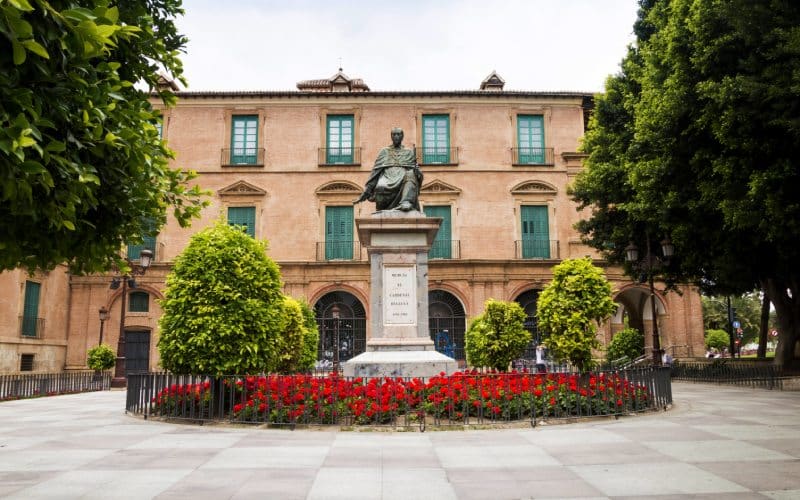
Murcia city.
Something similar occurs with the city of Murcia, head of the enormous Segura orchard. It is not clear whether it was started by the Arabs or whether they used an earlier Roman villa as a reference. In the Classical Era, the nerve centre of the region was Carthage Nova, the ephemeral Carthaginian capital in Iberia which was conquered by Scipio the African in the second Punic War. Be that as it may, during the early Middle Ages Abd al-Rahman II founded the population that has come to the present day. Its high point was during the resistance against the Almohads and when Alfonso X the Wise made it the rotating capital of the kingdom.

View from the castle of Alicante.
The three Valencia cities are part of the Autovía del Mediterráneo. The first one that can be seen is Alicante. As in previous cases, it dates back to pre-Roman times, despite what became important as the Roman Lucentum. Witness to its medieval importance is the castle of Santa Bárbara, the current patron saint of gunpowder. It has both a basilica and a cathedral. On the other hand, its port has been part of some of the most important naval competitions in the world, such as the Volvo Ocean Race.
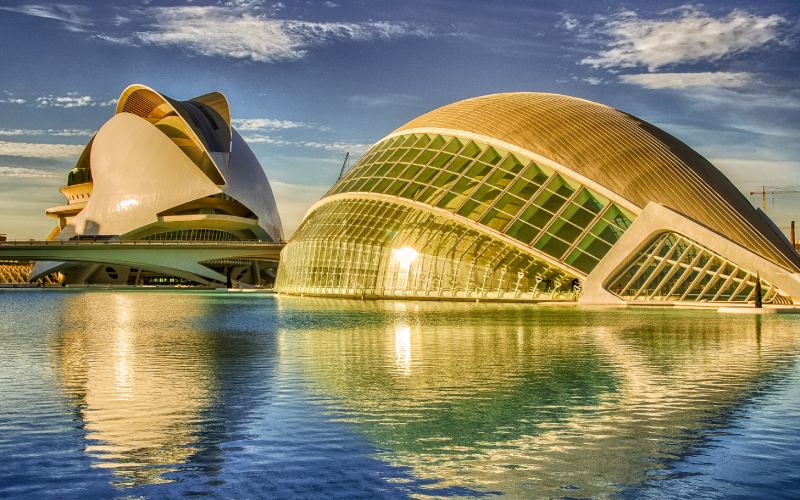
City of Arts and Sciences of Valencia. | Shutterstock
Valencia is the capital of the autonomous community and also has a long past. Its role in the legend of El Cid Campeador is well known. Legend has it that he defended it even after his death thanks to the tricks of his wife, Doña Jimena. It was once a renowned Roman colony, being one of the oldest towns in Spain. Nowadays it is a first class Mediterranean centre both in terms of commerce and culture. Birthplace of the paella, its Fallas festival is among the most popular in the country.

Centre of Castellón de la Plana. | Shutterstock
Further north, Castellón de la Plana dominates a large esplanade that prospered under the Christian fortress that protected it. It was thus an important defensive nucleus of Aragon against the Muslim pressure from the south. Beyond its temples and the castle, it has beautiful later elements such as the bell tower of the Fadrí, the Lonja del Cáñamo or the municipal palace.
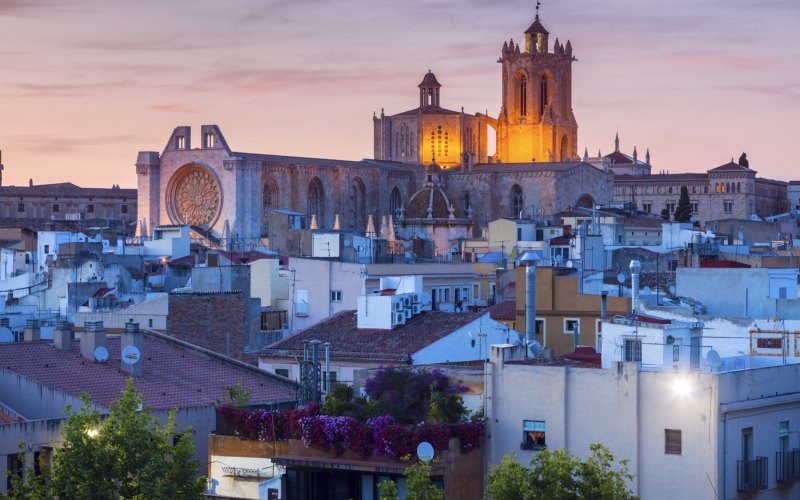
Tarragona, general view and cathedral.
On Catalan soil, the A-7 passes through Tarragona and ends in Barcelona. The sights of Barcelona are so great that they would require a visit of at least three days. The footprint of Dalí, the imposing port, the Sagrada Familia… For its part, the capital of Tarragona has a great Roman legacy and, like Cartagena, was a provincial head at that time. Apart from its oldest elements, its cathedral, the viewpoint of the Balcón del Mediterráneo or the Rambla Nueva stand out.
Nature is perhaps the greatest attraction of the A-7. Directly on it or with minimum detours you can find a multitude of places where it is worth stopping for a while. Right at the beginning is one of the most important, the Parque del Estrecho, which reaches Algeciras and its bay. This environment is a perfect area for birdwatching. In the same area but inland, part of the Alcornocales Natural Park is also accessible.
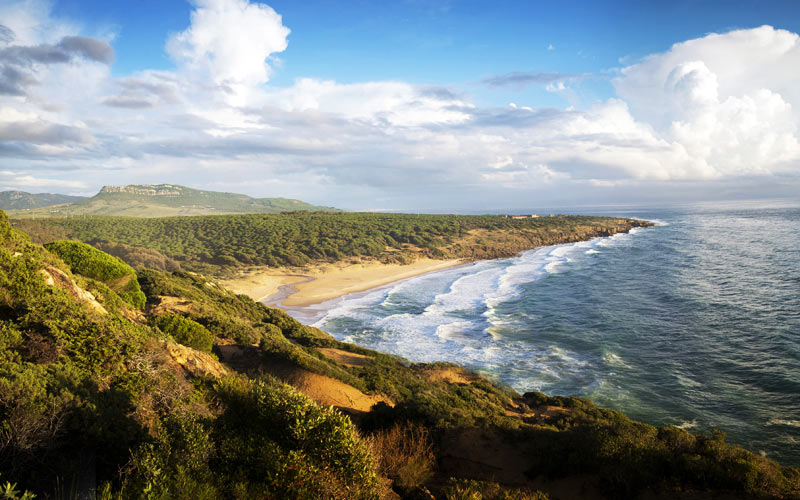
Parque del Estrecho.
The next big landmark is the Cabo de Gata-Níjar. Its lighthouse is a symbol of Almeria. Its main value comes from the great aridity it presents and from its sea beds. Especially notable are the forests of Posidonia oceanica, an algae that houses an ecosystem of great biological value.

Cabo de Gata in Almería.
Once in Valencian territory, after several mountain ranges of interest already mentioned, the Albufera de Valencia is the main wetland in the area. Over the centuries it has been used to grow rice and to support endemic species and migratory birds. Next to Castellón de la Plana, the Desert de les Palmes gives a misleading name to the area. Although if there are many palms, it is by no means a dry and empty place.
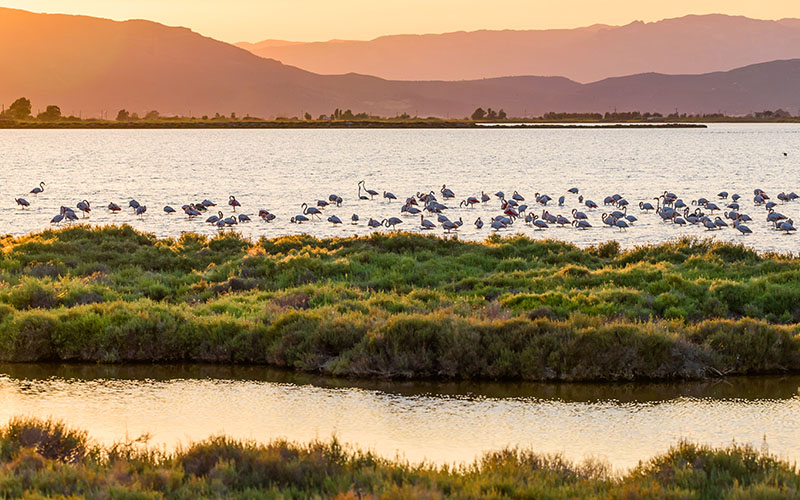
Ebro Delta.
Finally, after the Irta and Montsiá mountain ranges, the Ebro Delta is the last great natural element of the A-7. The largest river in Spain has generated this enormous wetland thanks to the materials accumulated over thousands of years.
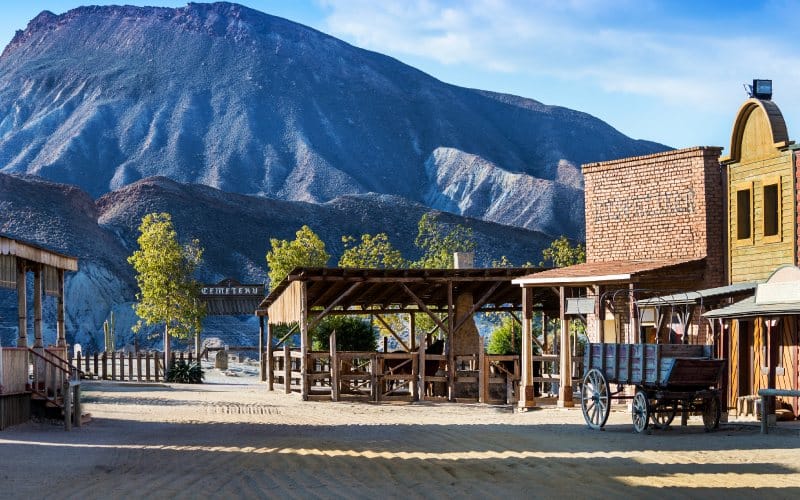
Desierto de Tabernas.
This route has the honour of having two desert environments on it. One is the only pure desert area in Europe. This is the environment of Tabernas. Its peculiar appearance has made it one of the main film locations in Spain. The mountains that surround this territory mean that there is a great absence of humidity. This has led to the development of a fauna and flora that the current nature reserve protects. The town that gives its name to this arid terrain is worth a visit, especially its church and castle.
The Phoenicians, Greeks, Carthaginians and Romans used the Spanish coast as an elementary point in their commercial and military expansion. The A-7 passes through many important points of antiquity. Shortly after leaving Cádiz is one of the most important, Málaga. Originally it was Malaka, a Phoenician settlement that ended up under Roman control. Its Roman theatre is a good example of the legacy that is preserved in the place. In the province the thermal baths of Manilva or the Villa Caviclum in Torrox are outstanding.
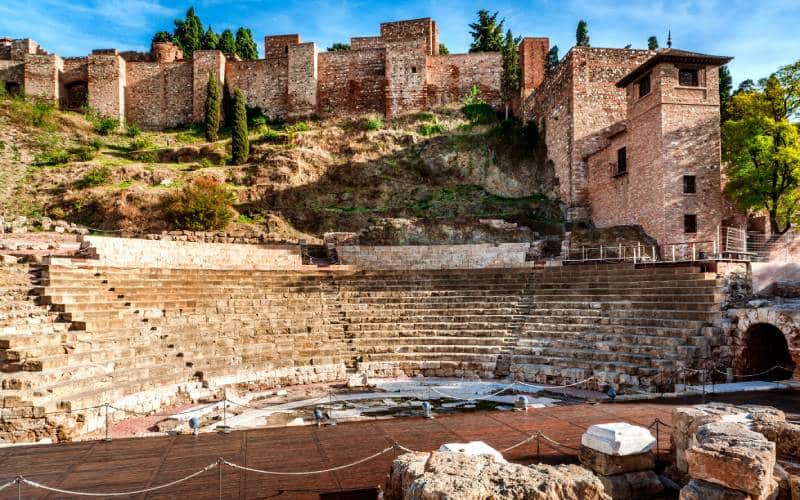
Roman Theatre in Malaga. | Shutterstock
All along this coast there are small remains of garum factories, a fish-based sauce that was very famous in the Roman Empire and served to preserve food for longer. The fishing tradition was already important at that time and focused on this sauce. High prices in the rest of the Mediterranean made the local colonies prosper.
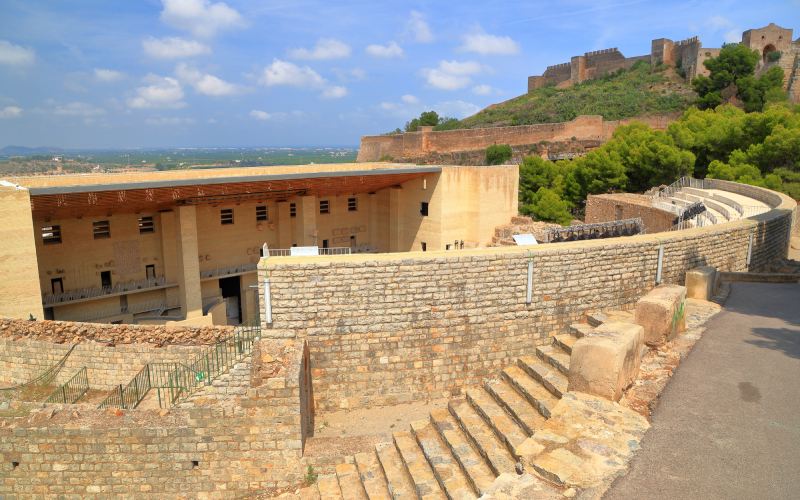
Roman Theatre of Sagunto. | Shutterstock
The Lady of Elche is the best known element of that city, despite being exhibited in the National Archaeological Museum. Not only was the Iberian presence important, but also that of the Romans, who gave it the name of Illici. They rebuilt it after it was razed to the ground by Carthage. The main remains are in the site of l’Alcudia. Something similar happened with Sagunto, whose capture by the Carthaginians gave rise to the second Punic War. In fact, the whole of the east was heavily involved in it. Its Roman theatre is the greatest example of what Saguntum, formerly Arse, was like.
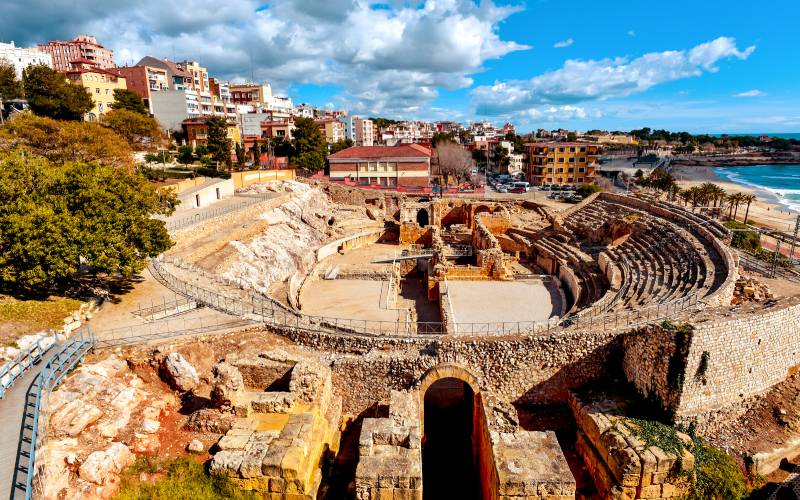
Roman remains of Tarraco. | Shutterstock
Despite the existence of other important settlements near the A-7, such as Lucentum/Alicante, the most important is Tarraco. Closely associated with the Roman family of the Scipios, Tarragona maintains a multitude of monuments that make its Roman layout perfectly recognisable. It is thus one of the main points for antique enthusiasts in Spain next to Mérida.
You can also read this article in Spanish here.